sassuolo -going public a text and diary on this city and this project
----- all arguments having to do with the actual legal proceeding to dispossess me of my own artwork: please, find here:
GOING PUBLIC – SASSUOLO AND MODENA
This text is a production dairy made
while working on the exhibition “Going Public” curated by Claudia
Zanfi and Marco Scotini in Sassuolo and Modena, September 2003. My housing
was unacceptable and one of my two assistants was not getting paid. This
irregular dairy gives a personal look into a specific case of today’s
exhibition management. It also offers an inside into a wealthy city that
is treating its foreign labor force in unfortunate ways. For this project
I was collaborating with the Arab population of Sassulo and therefore
was able to observe and experience what often is overlooked.
8/29/03
Sassuolo is a small city in northern Italy of approximate 50.000 inhabitants
and famous for the industrial production of ceramic tiles. The historic
city center is small and characterized by some historic plazas and an
impressively beautiful Renaissance castle. The surroundings of Sassuolo
and nearby Modena are dominated by industrial parks to produce, store
and distribute ceramic products. This region, Emilia-Romagna, is also
home to Ferrari and to Masserati, two other Italian success stories. Sassuolo
and Modena belong to one of the wealthiest communities in Italy thanks
to the high concentration of successful industries that profit widely
from market liberalism: Cheap labor from outside the European Union and
free exports with little monetary or customary restraints worldwide.
Claudia Zanfi was interested in my “Iraq Dialog” (www.ganahl.info/iraqdialogs.html)
work. This project consists in the exchange of ideas and opinions about
the current Iraq crisis with a group of Iraqi expatriates and refugees
living in Europe. As a first step I was creating “My own personal
war archive” with dominant news material concerning the Iraq crisis
taken from my U. S. television. (www.ganahl.info/wararchive.html) I was
isolating logos, titles, subtitles and other interface elements from this
footage. Subsequently, I was looking for Iraqi people living in Europe
who were willing to respond to these materials. The results were painted
on ceramic tiles and fired.
Tiles are often used in public places in the Arab world. They are indefinitely
durable and don't fade. At the same time, ceramic tiles are fragile and
can be broken easily. Primitive ceramics also were the sites of early
writings. Ceramics are similar to stones and carry as such meaning in
the current Middle East conflict. The glazes of tiles have the slick and
shiny look and the hard consistency of glass TV-monitors.
These graphic and textual info-landscapes characterizing news-broadcasting
in the U.S. are often very confrontational, aggressive, opinionated if
not even cynical, arrogant and scary: NEXT TARGET, SHOWDOWN IRAQ, WOULD
U.S. USE NUKES? These visually rendered interfacial media design elements
are partially selling, branding, justifying, authenticating and even cheerleading
news content. I wanted to re-contextualize them differently. I was trying
to do some idiosyncratic opinion polling with people who were directly
affected by this confrontation. I was looking to create a platform that
gives Iraqi people the possibility to write back.
Having used tiles from Sassuolo on previous works, I proposed to adapt
my concept to the given local situation: collaborating with the Arab population
working in ceramic factories. After months of preparation I have come
here to stay for 2 weeks preparing for this exhibition. I was promised
accommodation and some money to cover parts of my living and transportation
expenses.
The usual handshakes and small talk introduced me to Sassuolo’s cultural
director. In his office I encountered a beautiful black and white photograph
of indigenous people taken in Northern Africa during the Fascist time,
i. e. during Italian annexation and military occupation. Unlike other
former members of the Fascist Axis – the military and political alliance
of Germany, Austria, Italy and later, Japan – Italy was never forced
and confronted to deal with this awful and terrible history. Almost nobody
knows about the atrocities committed in Northern Africa by the Italian
military and their colonial masters. This ignorance and the nostalgic
beauty of the depicted young Arabs in the desert might explain why such
a photograph can hang unnoticed in the main office of cultural affairs
without creating questions about its historic context.
Arabs and Africans are today again in contact with Italy. They come here
to make a living, to work legally and illegally in all sectors of labor
that are not anymore the business of Italians. In Milan and other cities
African prostitutes can be seen nearly 24 hours in the city offering sex
work openly. In Sassuolo, the dirty, heavy and often unhealthy work in
dusty ceramic factories is according to the national and international
trend mostly done by legal and some illegal immigrant workers. Italians
often refer to Arabs and North Africans as “Islamisti,” “Islamists,”
reducing people to a confession. The latest trend on the migrant working
front is to replace Arab workers with South East Asian immigrants, mainly
from China. One employer told me openly his preferences stereotyping Arabs
negatively and as inferior. He doesn’t employ Arabs anymore.
On the way to my new apartment I am told that my temporary flat is not
only for me but also for another person. I was thinking of another artist.
We arrive at a very old simple housing complex that is exclusively reserved
for “Islamisti” and “extra-communitari” – people
from outside the European Union. My roommate, I was told, is an Arab driver
and spends only the weekend here. On the doors of his flat as well as
in the kitchen, I see some official letters that informed him that another
person is moving in temporarily. He was not asked whether he wanted my
presence. Indeed, the small apartment is filled with beds. A couple of
more beds are stored on a small loft area that shows visible traces of
former habitation. A walk through room between the kitchen and the bath
is assigned to me.
The hanging lock on my roommates’ door indicates little confidence.
The kitchen misses basic things: no single spoon, no single knife, one
glass only. This fact made me contact my neighbors. The first person,
an Arab man in his 50s was extremely stressed and expressed in fluent
Italian how miserable this place is. He hated it badly and told me that
he will move from here shortly. He has nothing to lend me. He complained
about leaking water, humidity, rats, cockroaches, pest and heavy noises,
all things I started to discover rather quickly myself. Cockroaches and
other insects are all over the place. They are ignoring the disinfectants
some additional handwritten paper is warning us of. Frustrated and without
any of the regular curiosity and friendliness my neighbor slams his door
on me: NO. I knock on another door with vital signs of social activities:
without any comment a large kitchen knife is handed over to me.
I have a strange feeling. I don’t know when this unknown, uninformed
roommate will arrive. How will he react when he sees me sleeping in the
middle of the living room? Who else has access and keys to this indeed
miserable and decayed housing unit? The curator and I leave to the better
quarters of this town and start discussing details of my work and the
exhibition. The city and the curator expect me to donate one of my works
without monetary compensation. They want me to install a ceramic mural
permanently in the waiting room of Sassuolo’s railway station. Given
the fact that artworks are having a price attached when exchanged I feel
very uncomfortable but don’t refuse it outright. I want to discuss
it. Now, I’m told and indeed have to even sign that I have no access
to the internet or to any phone line in the office. The office of cultural
affairs is very clear that they don’t want me to use either their
phone lines nor their computers. We finally agree that my work is going
to stay as long as the city of Sassuolo wants it. I stay the legal owner
of the piece. I decide to make this experience here in Sassuolo a study:
Since I am working with migrant workers why should I be treated and housed
differently? Only later I was told that Claudia Zanfi informed the cultural
office that it is OK to house me “this way:” She apparently
joked that I am “living in the Bronx,” an assumption that is
not only false but used in a racially and culturally biased manner.
For my ARAB DIALOGS I present a selection of U.S. media materials to Arab
workers of Sassuolo. I’m asking them to engage with my papers in
writing. I have prepared sheets of printed out news logos and headlines
concerning the Arab world I collected over the last couple of months in
New York. This graphic material usually accompanies news stories, news
analysis and expert talks. I ask Arab speakers of Sassuolo to write onto
my preparatory sheets whatever they think. These materials are then the
basis of a pictorial process on ceramic tiles. The tiles are painted with
the help of the painter Silvano Rutigliano and the calligrapher Siyam
Moshen. The works are fired with the generous help of FORME 2000, a ceramic
factory. The tiles were provided by VIVA a company based in Sassuolo.
Daily news reports on terrorism, suicide bombings, wars and killings create
an image of the Arab world that is frightening. This makes everybody -
Arabs and non-Arabs - feel uncomfortable and suspicious of each other.
Stress and distress, frustration and anxiety, paranoia and fear are in
the air, in the head of everybody and sometimes in the faces of people.
I ask my all participants whether I can take photographs and whether they
want to give an interview. In most cases, the answer is No. They suspect
troubles with the Italian police, the CIA, Mossad, or other groups. I
encounter barely anybody who doesn’t make a joke about being imprisoned.
Some ask me whether I am working for the CIA. A handful of people talked
to me in front of my camera and agreed to be recorded. Their real stories
and thinking are mostly told off camera: frustrations about their jobs,
housing problems and consternation on Middle East politics. Many chose
to be identified only by first their names or opt to give no name.
It is an interesting experience entering a housing complex reserved only
for “extra-communitari.” Young people receive me with curiosity
and suspicion. What does he want? Is he a police person, an informing
agent, or does he just look for trouble? Most housing projects reserved
for Arabs and Africans are dilapidated, covered with debris, destruction
and neglect. These housing complexes are easily recognizable not only
by their inhabitants gathering in the streets but also by their satellite
dishes that mushroom on the windows and balconies. We are speaking in
Italian and French. After an initial round of questions and explanations
we proceed with some results and my presence loses soon attraction.
Silvano and I went to Caffé Roberta for some drinks and some pizza.
There we also engaged with some Arabs and collected some writings. After
a couple of minutes the bar owner told us in a rather rude way to leave
his coffee house. His place was well equipped with recent surveillance
technologies displayed prominently over the counter. His red boiling head
was leaning aggressively over our table reminding me of classical German
watch dogs barking nearly in every garden of this city. Fear of Arabs
is visible in this town.
Today, a neighbor of mine introduced himself on the staircase: “How
much do you pay for your place?” I explained my situation and redirected
the question. He lives with two others. These Turkish Kurds pay for a
small housing unite 675 Euro and are frustrated because nobody else is
renting to them. Real estate agents have clear instructions what to rent
to foreigners. This young man told me of discriminations he has experienced
here. The full extend of this kind of housing injustice becomes more and
more apparent to me. A really nice Moroccan man from downstairs invited
me into his apartment. We spent an entire evening together. Beans were
cooking while Egyptian soap operas filled his TV screen. He is 47 and
participated in my project with two beautifully written responses. He
told me that he is forced to live with two other workers each paying 225
euros for a total of 40 square meters. Asked about this housing complex
I got a perplexing answer: the city of Sassuolo is in charge. The city
keeps a housing shortage for foreign laborers which squeezes them financially.
It has to be added that average rent in small towns in Europe is much
lower and would be far from 675 Euros per unite. The quality of housing
is so poor that barely any rent could be collected for these unites had
there not been this shortage and this racially biased exploitation. The
frustrations over these conditions are unfortunately finding their expression
in the almost daily eruptions of domestic violence. Nearly every evening,
the house shakes with painful verbal and physical attacks. Glass and objects
are smashed. It feels as if these tight and disgusting living conditions
forced on people are driving some to insanity. Insanity in these old humid
walls is distressfully loud and periodically repetitive.
The contrast between the clean outlines of these new factory structures
and the housing misery of their workers is shamefully huge. In the afternoon,
I saw an Arab woman slowly walking along an endless factory building that
resembles some anonymous fortress with thin vertical windows. The mass
of this concrete compound almost captured the woman carrying something
in the long shadow.
8/31/03
This evening I was invited by the frustrated man who closed the door on
me two days ago. He showed me the desolate conditions of his housing unit:
Water running down on walls, dangerous cracks in his stone brick ceiling,
electric cabling that invites fires – a worker of FORMER 2000 lost
his life in a house fire in Sassuolo – and lots of dust dripping
from the cracks in the ceiling and the walls. The street with heavy truck
traffic passes directly above his window. This man from Tunis has caught
Asthma, a condition he never had suffered before. He demands a better
location but is not offered any other place. Having gone on rent strike
he now faces eviction within a short period of time without any alternative
provided.
Given the treatment and the prejudices I have encountered in Sassuolo,
an Arab foreigner is a persona non grata outside the working place. These
“extracommunitari” have very little chance to be accommodated
in a decent place paying correct rent. They literally are “ex-communicated.”
My neighbor even paid some architects and some health officials to inspect
his place. Additionally, he hired a lawyer for his cause. Complaints by
all these people have so far not produced any result from this city that
is hosting me as well. His frustration is best illustrated with a dead
mouse or rat he just stamped with his feet near his bed before I visited
him. The rodent was sticking in its dried up blood on a sheet of paper.
It seems that rats are surviving the “deratificazione” campaign
– rat poisoning signs are displayed everywhere –that is currently
under way. May be, a large black cat didn’t. The cadaver of a cat
is lying now right at the entrance of our housing complex.
Today, I spent mostly talking to Arab workers and collecting their written
reactions visiting Arab housing projects. I get to know more and more
people. I begin to recognize them in the streets I have talked to before.
This makes me think of Frantz Fanon’s descriptions of the Arab city
where children seem to “belong to nobody.” I am loosing all
reservations and feel comfortable being surrounded by even concentrated
rough teenage energy. I am not anymore concerned about my cameras and
other things I carry with me. These quick youngsters also sense that I
am fearless and interacting naturally. I was asked by several young men
how to emigrate to America or to Austria.
The majority of people I have talked to are only interested in tolerance.
They are strongly underscoring that they don’t hate American people.
Everybody shows contempt for the current Bush administration. When conversations
continue, some people unfortunately equate very quickly America with Israel,
Americans with Jews. They do this even when they express compassion and
sympathies for regular people, whether they be Jewish, American, or Christian.
To my sad surprise this non-sense anti-Semitic equation I am also encountering
by Italians, Swiss and others, not working as underpaid laborers. Some
reactions in Arabic promote hatred and open anti-Semitism, something I
exclude from my project. My Palestinian calligrapher Siyam refused to
transfer any of these hostile reactions. The majority of writings was
not hostile, anti-Semitic or hateful.
September 1, 2003
The contrasts of this city are remarkable. Nearly all factory buildings
are characterized by a spacious geometry. They enjoy an abundance of open
spaces. Industrial points are connected efficiently by wide streets with
good lightening. The housing projects reserved for non-EU laborers are
overcrowded, driving prices to levels paid only in chic metropolitan zones.
The main street leading into the center is so small that my life is seriously
at risk riding my bicycle on the street. Several kilometers are badly
lit and bicycle lanes are missing. Given the heavy truck traffic all lanes
are too narrow. Even in the center of Sassuolo, many streets need repair
and pedestrians and bicycles don’t matter to car drivers or city
planers. Sidewalks and the few existing bicycle lanes can end absurdly
leaving priority to cars. I really wonder why this very wealthy city is
not reinvesting money into its basic infrastructure.
The city of Sassuolo is cheap not only with foreign laborers and artists
like me but also with its library. In a city of 50 000 inhabitants, the
main library offers only one computer with a slow internet connection.
There is no internet caffee in town. A swimming pool exists but the entrance
is so expensive that not even regular Italians are always profiting. The
fee structure guarantees that it is not used by members of its immigrant
labor force. More money has been invested into security. An impressive,
large high rise structure is about to be completed for the town’s
police head quarter. This one way glass structure doesn’t really
resemble a police head quarter but looks more like of a financial center.
It is placed between the majority of their ‘extracommunitari”
housing projects and the local mosque. Since quasi-completion of the semi-circular
police structure the mosque moved a few blocks away in order to escape
the panoptic perspective of the police headquarter. Policing seems to
be smooth but permanent. Police cars cross green parks and industrial
zones. Their cars can be seen any time anywhere.
Some workers from Morocco and Tunisia told me about their visa situations.
Many are not allowed to bring their families, since children over a certain
age are not granted any visa. Many visas are issued only for short periods
– 3 months – which creates additional stress pressuring people
even more into distressed working and housing conditions. To my surprise,
agents for these local industries are sent to Morocco and Tunisia advertising
work. They promise work which they can’t always provide. The efficient
logic of scarcity and insufficient supply isn’t here only applied
for the city’s depressing and exploitive housing policy but also
for its way of handling migrant labor. Having an abundance of workers
at hand depresses prices and many I talked to are working for 5 Euros
an hour. So far I haven’t met anybody who is paid more than 7 Euros
an hour.
I am just learning more about my roommate situation. Somebody showed up
at my door at 7 30 am and asked for my roommate. I have no information
to give but he told me that two brothers are usually living here. I was
only informed about one person who might show up at any moment though
he is believed to be on vacation. I was never told about two people living
here with me. This is the logic of how these houses work: the city can
assign anybody at any time into any apartment, just the same way I have
been parked here without my consent or the consent of the people living
here. The last time, I encountered this practice personally was in the
Soviet Union where families too were assigned to apartments by city officials.
In Sassuolo, global capitalism forces people into soviet style living
conditions. I understand very clearly that anybody can walk in here at
any time, while I’m away or sleeping. This person might be less informed
about me than I am about him. Thank you Sassuolo for your generosity!
9/6/03
VIVA donated us larger than imagined tiles. This allowed us to work very
quickly and master larger size works. FORME 2000, the factory I’m
working at can fire thousands of individual pieces fully automatically
within a couple of hours at any time a day or night. This is why I can
make more pieces than originally planed. I am very excited and my assistants
share my enthusiasm. Silvano and Siyam are very accomplished painters
with big skills. They are able to transfer the material quickly without
any tracing or copying. This changed situation has made me adapt my concepts
to these new and highly improved production conditions. I can work on
large scale pieces. The curator promised me that we will be able to install
my pieces in a large plaza.
These efficient and generous working conditions make me forget the rest
of the situation. I even don’t mind having difficulties to sleep
since this place here – barely less dusty then my working environment
– gives me Asthma, a child disease that returns when I find myself
staying and sleeping in small dusty places. Even after so much exhausting
work, I can’t sleep for more then 3 hours. I am sitting here at the
computer shaking with Asthma . When breathing becomes a problem only my
mind is left to wonder and observe freely. Almost like a scanner, I recall
what has happened to me. My curator was yelling at me for producing too
much work. Her position is contradicting because on one hand she wants
me to cover a plaza and on the other hand she objects the fact that I
make all these artworks. Today, the cultural head of Emilia-Romagna visited
us expressing big interests in my work. Due to this, he decided ad hoc
to spend extra money on the catalog and print it in colors.
Silvano is less excited since he was clearly told again that he is not
getting paid for his week long work. Claudia Zanfi considers him a friend.
She obviously uses her status as a curator to pressure this young artist
into services. This is unacceptable to me. Apart from the fact that I
give Silvana and Siyam art works of mine I do really expect my assistants
to be paid correctly. My images of this apartment to the second curator,
Marco Scotini caused some effect: for the time of the opening I’ll
be granted a hotel room. Suddenly the city can afford it. I am also convinced
that the city could pay my assistants if I make more pressure. This is
another reason to write. If the budget of a catalog can be nearly doubled
with just a visit and a word, then, my assistants can also be paid correctly.
Today we are confronting a new conflict. The permanent piece for the railway
station which I am supposed to donate is to be installed and decided upon.
For purely aesthetic reasons I opt for the size of 75 x 120 cm. But the
curator, Zanfi, decided on the phone for the size of 100 x 160 cm. I think
that it is too big for a wall that measures only 280 cm. Bad installations
ruin art works and therefore need to be solely the business of the artist
who is ultimately responsible for it.
I’m quite amazed that this work of mine can be installed publicly.
Almost every response I have gotten could be seen as a provocation to
the official versions of Italian politics: The Italian prime minister
Silvio Berlusconi who only walks around as a free man because he manipulates
Italian immunity laws promised carte blanche to all the political and
military activities of the White House. I’m excited that local and
regional decision makers are supporting an art project that tries to deal
with the voices of subalterns, of Arabs stating their disenchantment with
Western politics and Western media. The pieces they allow to be installed
in public spaces in Sassuolo and Modena are including not only Arabic
graffiti but also the following media titles: CIVILIAN DEATHS UNAVOIDABLE
and POST WAR THREATS, MILITARY RESPONSES. This is happening in a land
that doesn’t really appreciate foreign languages and usually objects
to materials that remind them of the fact that Catholicism isn’t
the only doctrine in town. I am amazed that my work that clearly addresses
the issue of war will be installed more or less permanently in a public
space of significance: the local train station. I am curious about the
reactions it will create in the Arab and non-Arab population. The piece
is accompanied with a clear translation and an explanation in Italian.
I wish this work and my text could have a small impact on the status quo
of foreign workers. I do think that this wealthy city could improve things
easily for its working population that is so crucial to the production
of industrial wealth: better housing, better after-work-programs and sufficient
available and cheap if not free communication centers could easily make
a difference. When things are bad for large segments of the population,
it is not only enough to blame just the city government. It is also a
the fault of the local press that ignores the situation or is complicit
with it. The function of the press is to clearly inform that politics
creating injustice and frustration damage everybody on a long run: the
city will pay the price in form of security and integration problems.
Sassuolo will become ugly and will have difficulties to keep and attract
qualified workers. It is also frustrating to see how an architect and
design talent like Siyam Moshen goes unnoticed and without any work.
9/22/03
I’m back in New York. During the days of the opening I was housed
properly in a hotel. In spite of my clear indications my work wasn’t
installed properly. The positioning is wrong and my clear instructions
for installing were ignored. This resulted in the damage of one piece.
Yet, the most significant disappointment is the fact that the titles of
my works were changed. Instead of “Arab dialog with … “
the title of the work was altered to just “Arab Dialog.” This
really means that my Arabic dialog partners were edited out from the title.
To my disappointment and against my insistence changes were not made immediately
for the opening. I was promised that these will be made later. The same
negligence and changes apply to the catalog. Titles seem to be of no concerns
to both of the curators: the printed publication presents all images without
any captions. Only in the back of the book one can find titles if being
patient. Given the conceptual nature of all the works of our show, I am
stupefied by this practice of title separation: it renders images arrogant
to anybody who is not informed. The financial closer was also quite disappointing:
Siyam Moshen was given only 200 Euros for one week working with me. This
barely paid for his two hour driving daily. My travel costs were shortened
by 50 Euros in order to “pay more to the assistants.” After
some verbal confrontations Silvano Rutigliano received finally also 200
Euros for his work. For me at this moment, many logistical problems still
remain unclear and unresolved.
On a widely listened local radio show I was able to talk 20 seconds about
the insufficient conditions of immigrant workers in Sassuolo and Modena.
I explained this sad situation also to some political representatives
of the cultural establishment. Their reaction was silence and their eyes
wondered around the floors.
Rainer Ganahl
www.ganahl.info
POST SCRIPTUM:
The curator Claudia Zanfi found my text on the internet and forced me to take this text off line. She threatened me not to return my art work and legal steps. I took the text off the internet. Yesterday we managed to savely recuperate all works including my long time work I intended to leave there for longer. I decided to take it back since the administration never found it necessary to send me a paper of receipt, or a loan agreement.
below find all the nusty legal stuff to disposses me of my art work here:
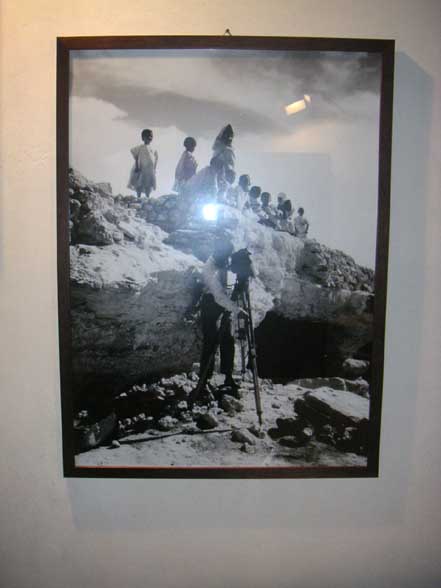
This photograph is hanging at the cultural office of Sassuolo. It shows an italian photographer (most likely Italian) with Northafrican kids. Most likely the grand parents of the youngsters today working in Sassuolo). as I was confirmed this picture was taken during the fascist years when Italy under Musolini brutally invaded and annected this part of Africa.
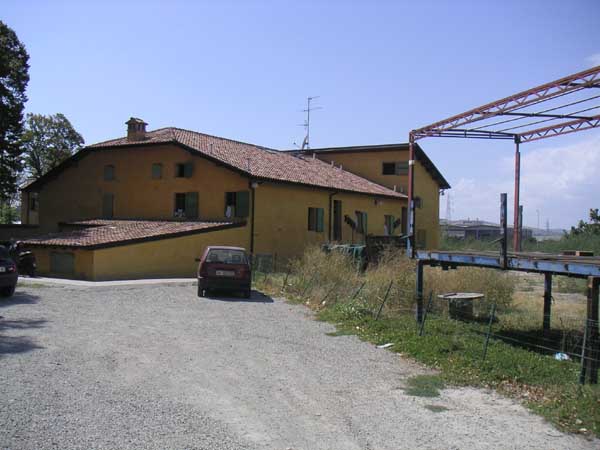
housing complex I was staying
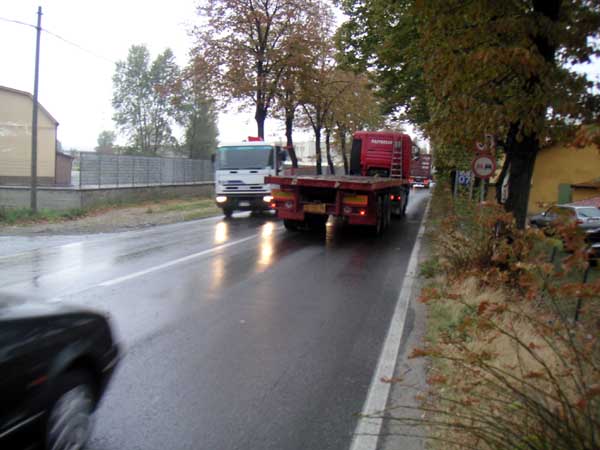
in front of our windows. notice how dangerous it is to use the bicycle which I and many others were forced to do. As you can see on the opposite of the street there is space for a bicycle lane but nothing is done by the city.
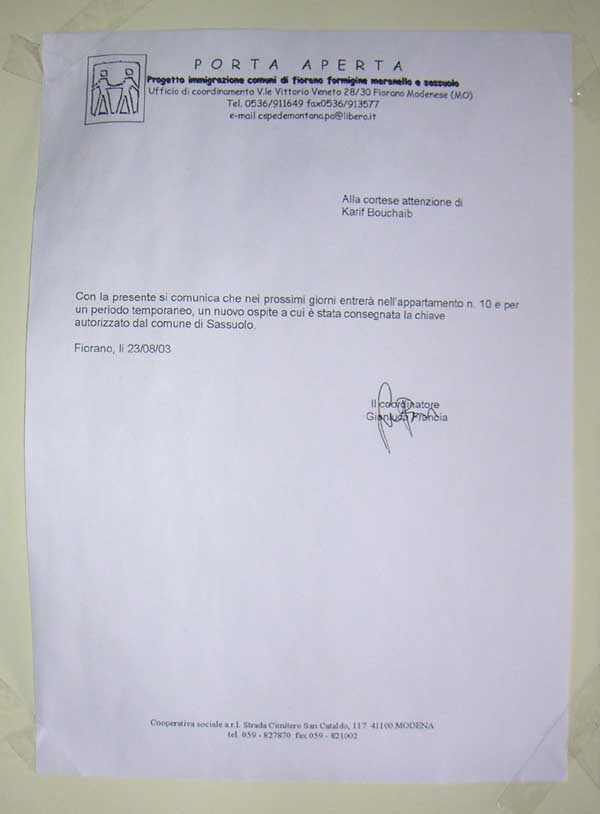
letter indicating my arrival to the people living already in the appartment.
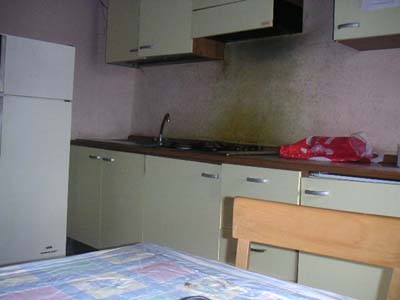
view from my appartment I had to share with 2 other migrant workers who happened to be on holliday. kitchen view.
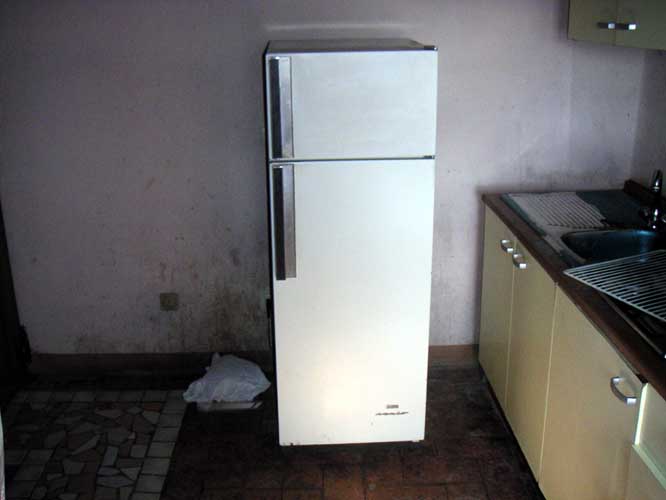
ktichen view.
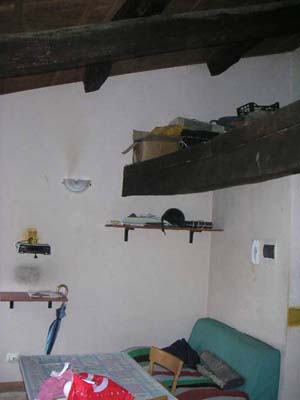
view of my appartment - one bed with loft area that alos shows signs of habitation.see photo below.
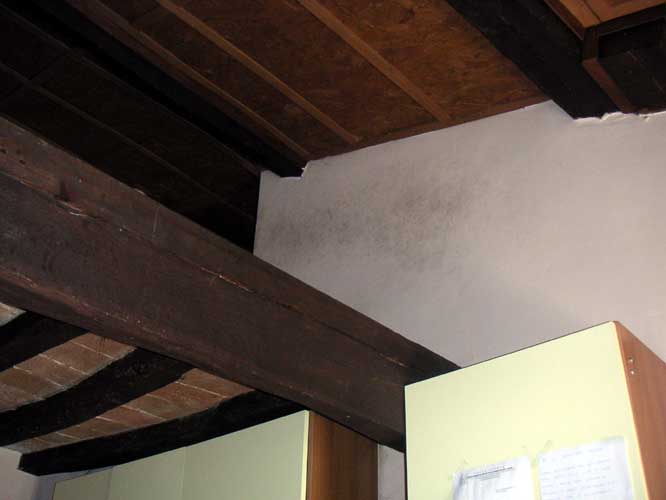
signs of habitiation in tiny y loft area. beds are everywhere found. please, also notice the special stone floor of the loft ceiling. in many parts it shows cracks which produced not only danger - the stones can come down - but also permanent dust.
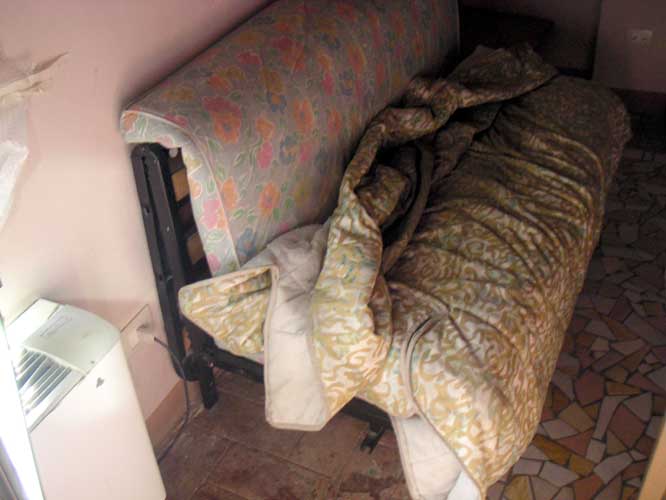
some more bed. the blanket was in a special condition since it had been used heavily.
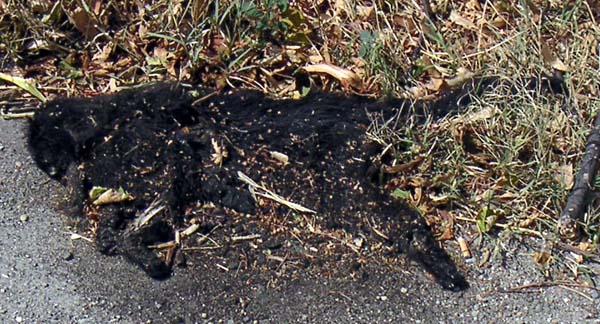
dead cat lying at the entrance to the housing project.
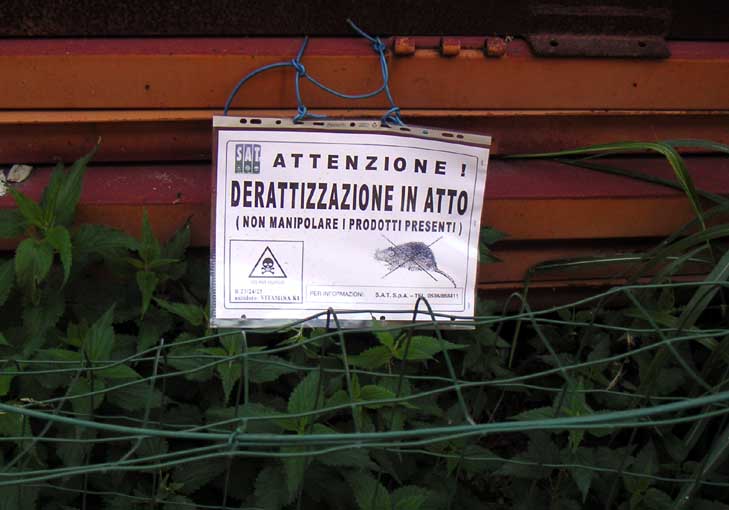
sign warning of products that also control rodent.
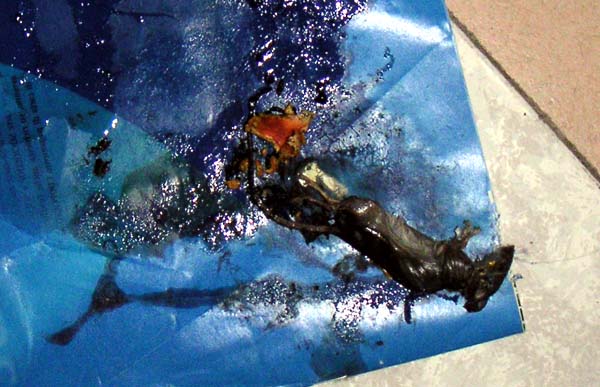
rat or mouse controlled by my neighbor in his appartment below.

contrasting view from my window. notice the clean architecture of these gigantic ceramic factories and storage places.
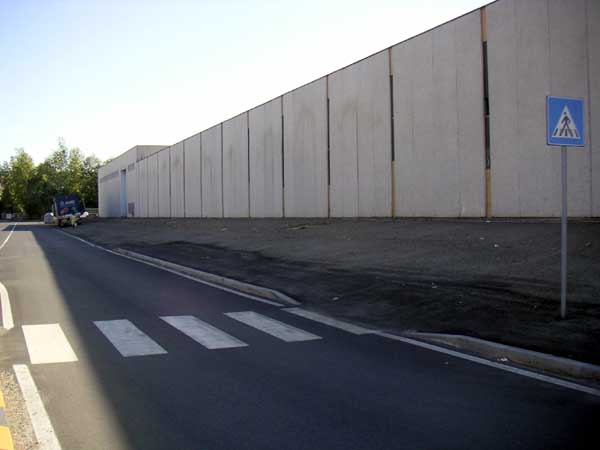
Sassuolo, factory view.
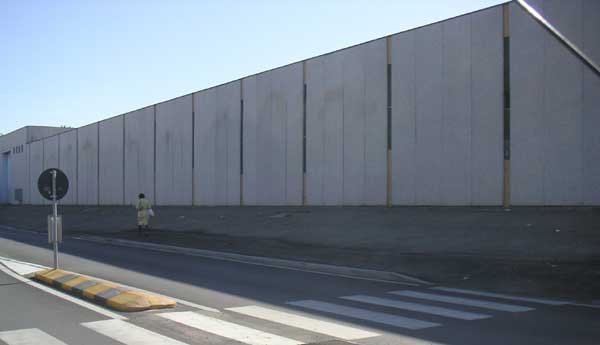
Sassuolo, factory view with woman walking.
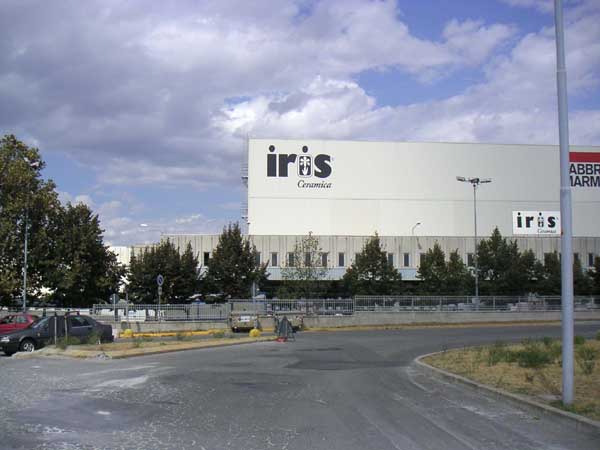
notice the abundance of space. yet when looking closely there is no space for bicyclists or people walking. just for trucks.
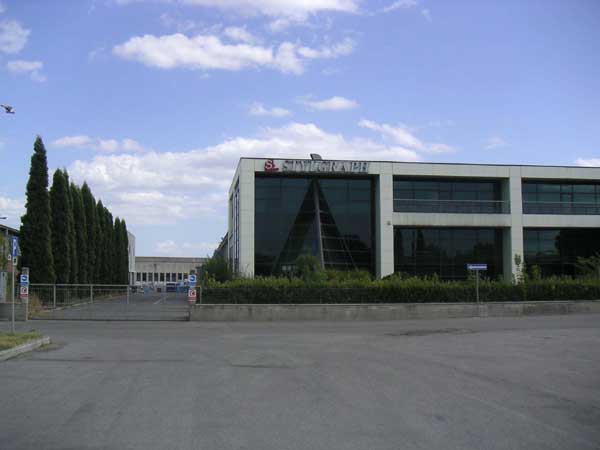
corporate architecture going post-modern.
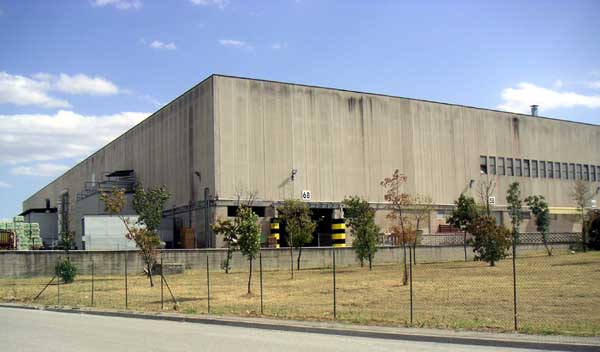
ceramic rules
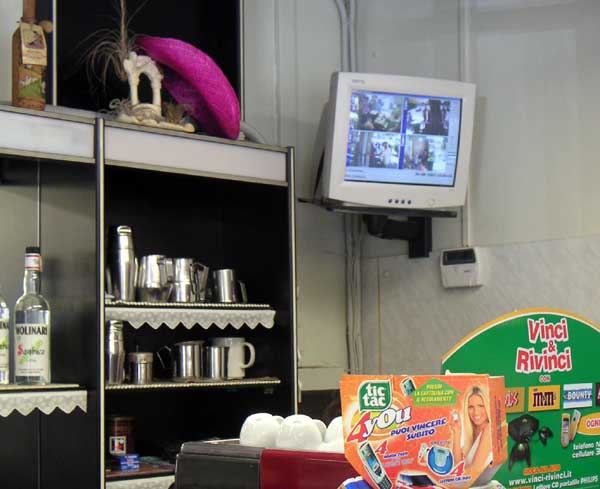
electronic security in a bar from which we have been kicked out because of interating with Arabs for my project.
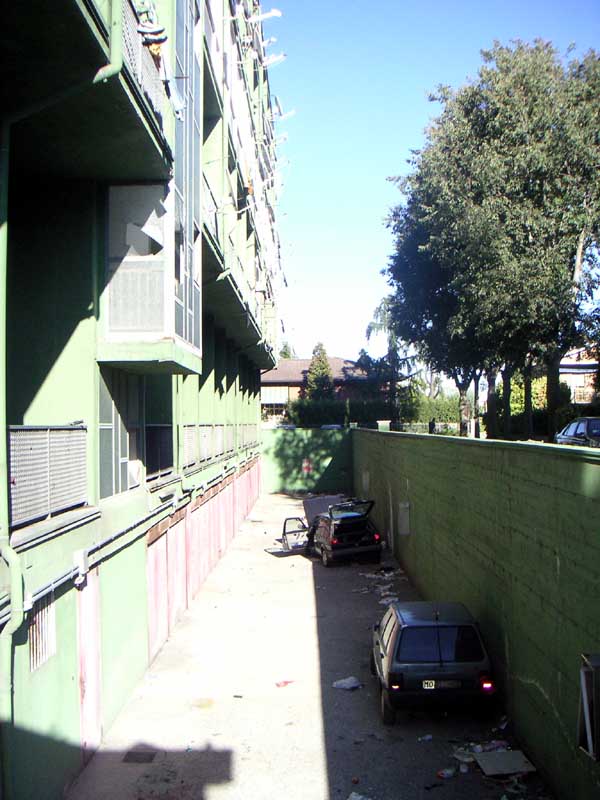
houseing project for Arabs in Sassuolo.
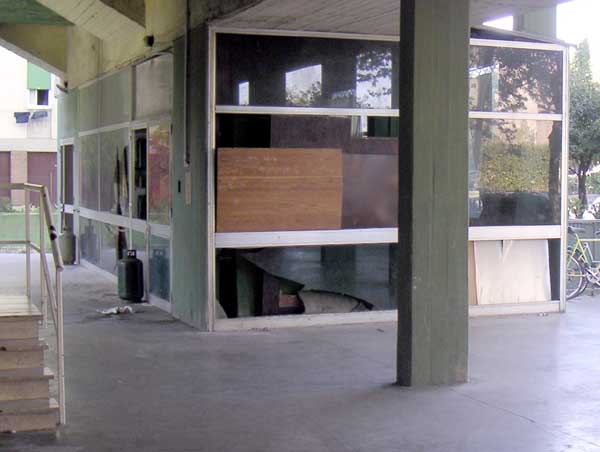
houseing project for Arabs in Sassuolo.
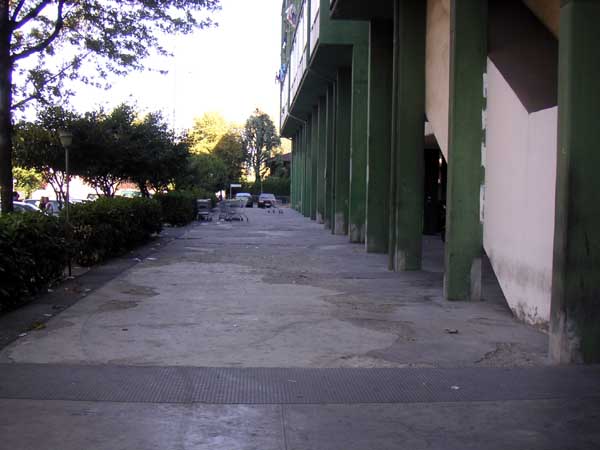
houseing project for Arabs in Sassuolo.
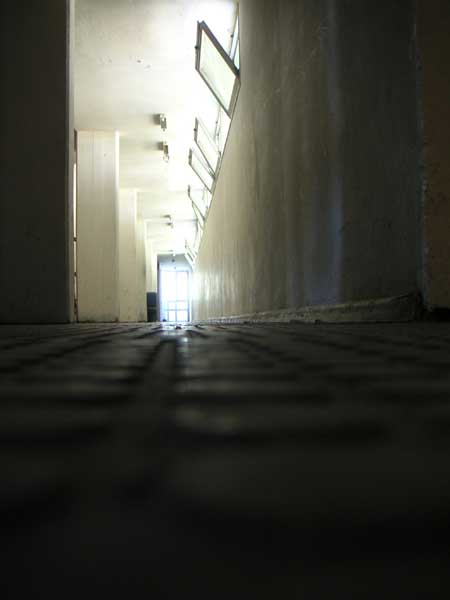
houseing project for Arabs in Sassuolo.
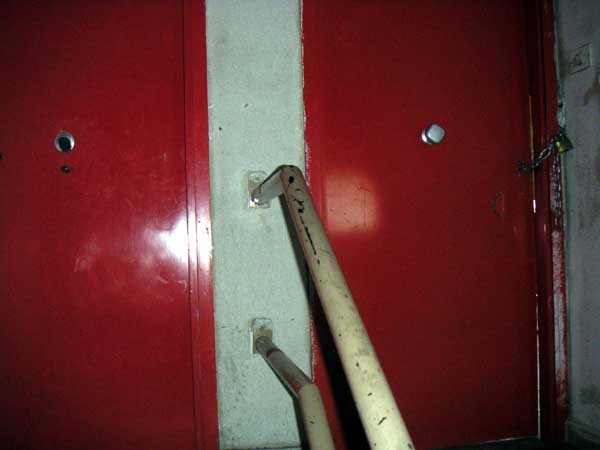
houseing project for Arabs in Sassuolo. almost the same view I had in my own appartment.
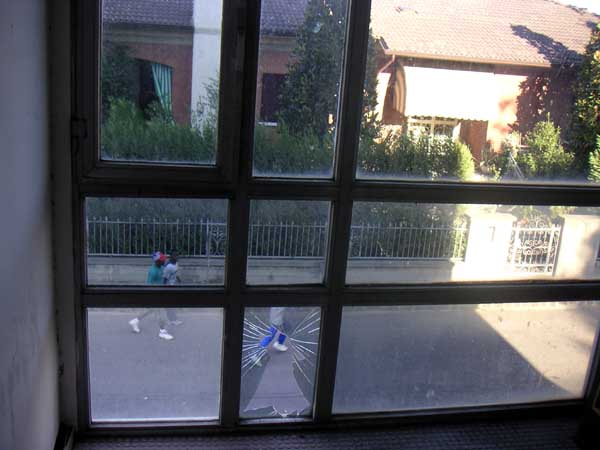
houseing project for Arabs in Sassuolo.
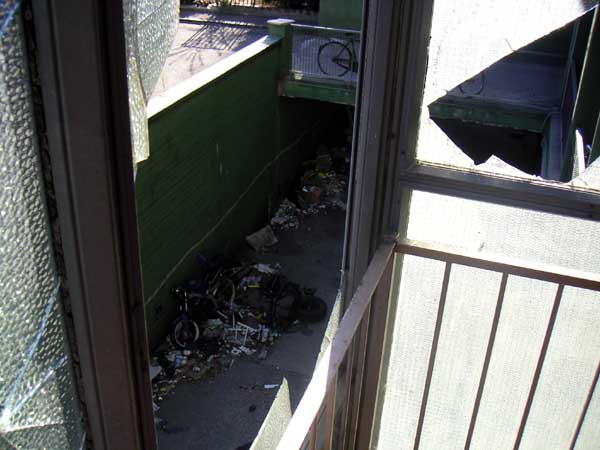
houseing project for Arabs in Sassuolo.
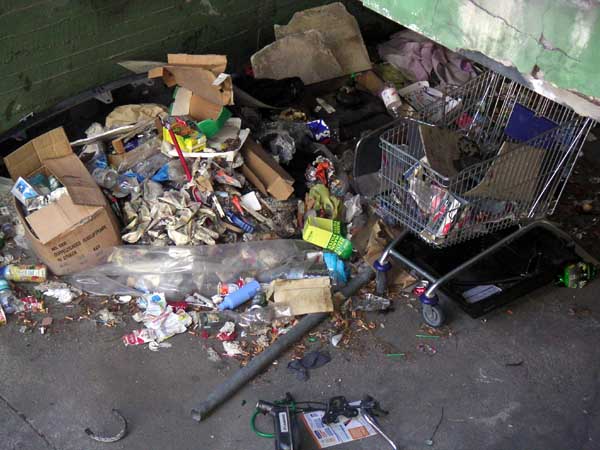
the city of Sassuolo reallydidn't seem to care too much how their workers live.
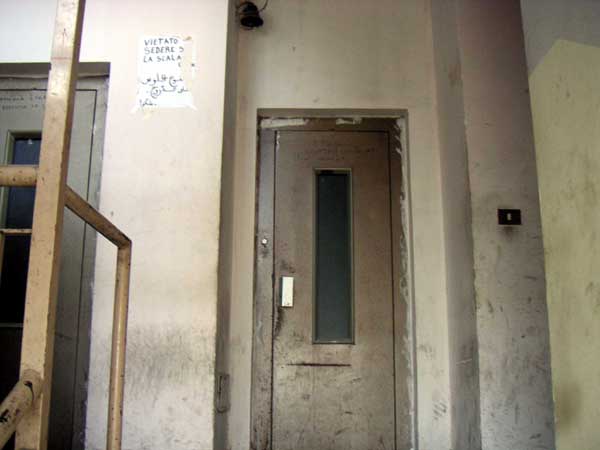
houseing project for Arabs in Sassuolo.
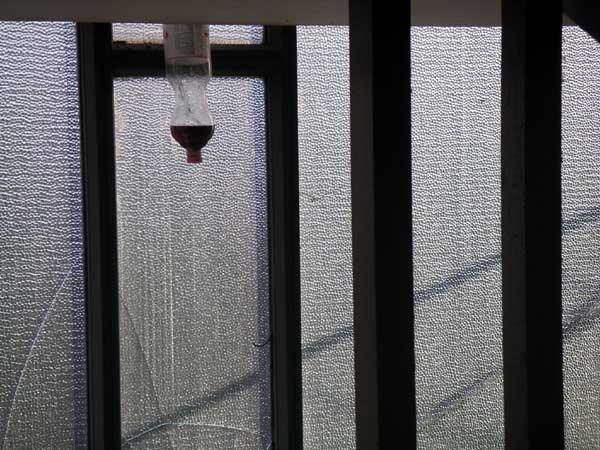
houseing project for Arabs in Sassuolo. this bottle was hanging between floors.
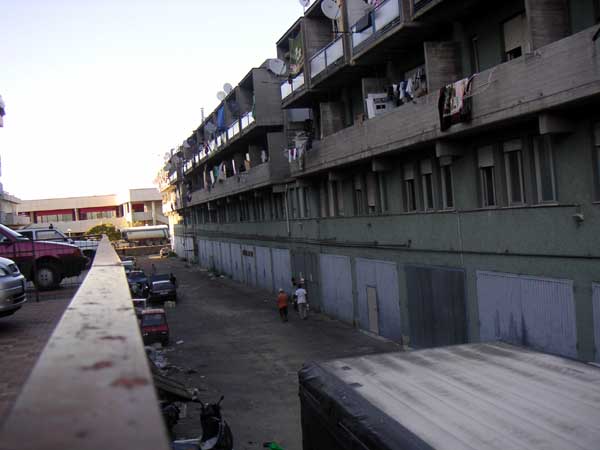
houseing project for Arabs in Sassuolo.
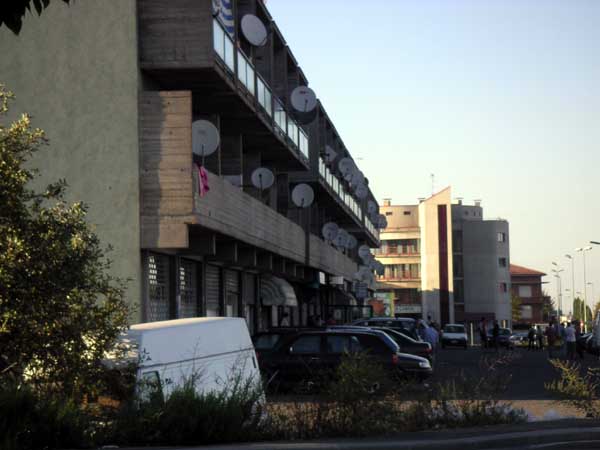
houseing project for Arabs in Sassuolo.
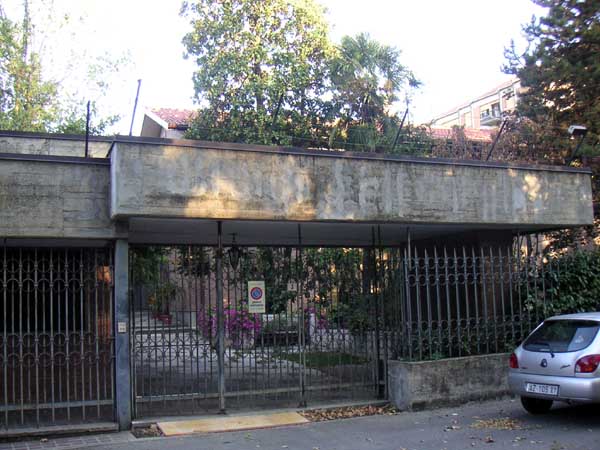
security seems to be of an issue for the better part of the rest of the city.
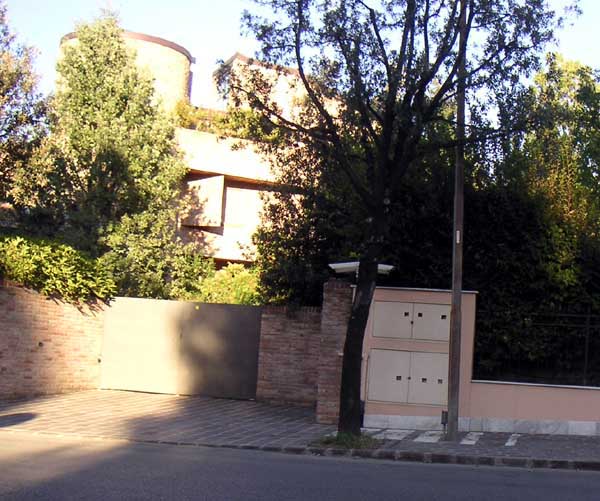
cameras, gates, and more...
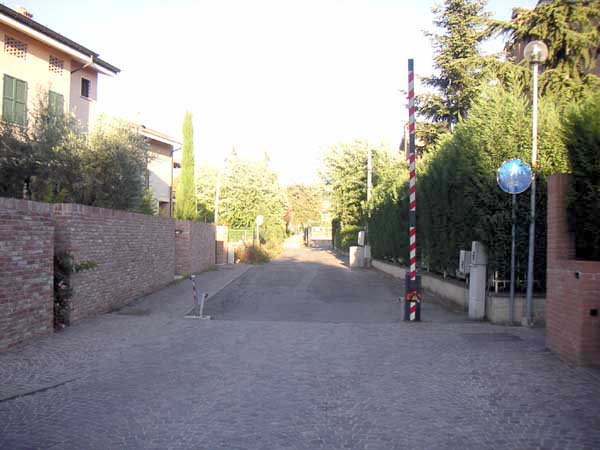
here, security concerns convert public space into private space with a gate. this is common practice in L. A. and other places. I was astonished to find it in Sassuolo.
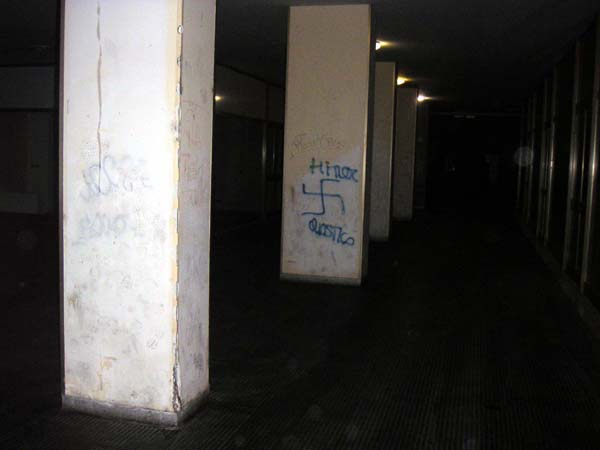
some people thought that they needed to give a public course in political semiotics: it says "Hitler swastica"
LEGAL EXCHANGE:
3/3/04 - the work that I lent to the city o Sassuolo for which I never received a proper loan sheet, we had picked up. a couple of days later, Zanfi sent a threat to the Museum and demanded the return, claiming that the city OWNS IT. the museum in vienna was concerned about their reputaton and returned the work immediately. I was not informed in time.
here the document which zanfi used to claim ownership:
a document was manipiulated - title of the piece was written later - ,it has a wrong date (spet 29 I was in nyc) and that includes wording that I didn't even understand when I signed it against my will in italy. I made it very clearn and I was assured taht this was a loan agreement and that I would be given a proper loan agreement and was asssured that this paper doesn't claim ownership.
here is a letter by Luigi Benedetti who is hte head of hte culture ministry of the department of Emilia Romana.
From: Benedetti to me:
On 10/17/03 2:31 PM, "Benedetti Luigi"
Dear Rainer,
I'll prepare and send you a consignement for the work in Sassuolo as soon
as
possible.
It will be a document (in italian) approved by my administration and signed
by me.
I know you're right and I agree with you when you say that artists are
expected to sell their artwork.
But I have only small funds, and I think these funds shouldn't be enough
to
but your work.
I don't want to give you the impression I'm haggling about the price,
but
unfortunately I can't afford to spend more than 2.000 €.
I hope I haven't offended you, but these are our real possibilities.
With best regards
Luigi Benedetti
------------------------------------
the loan agreement was never sent:
below see the letter sent to the museum where they claim ownership:
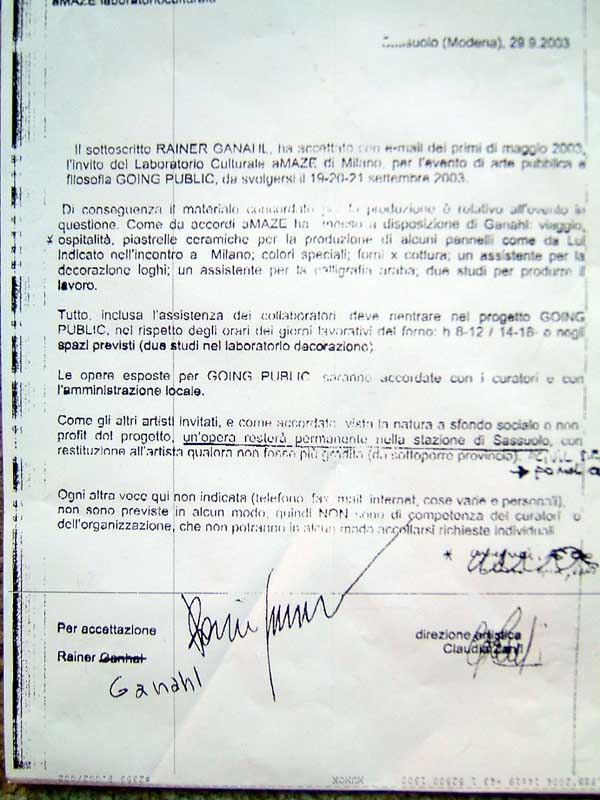
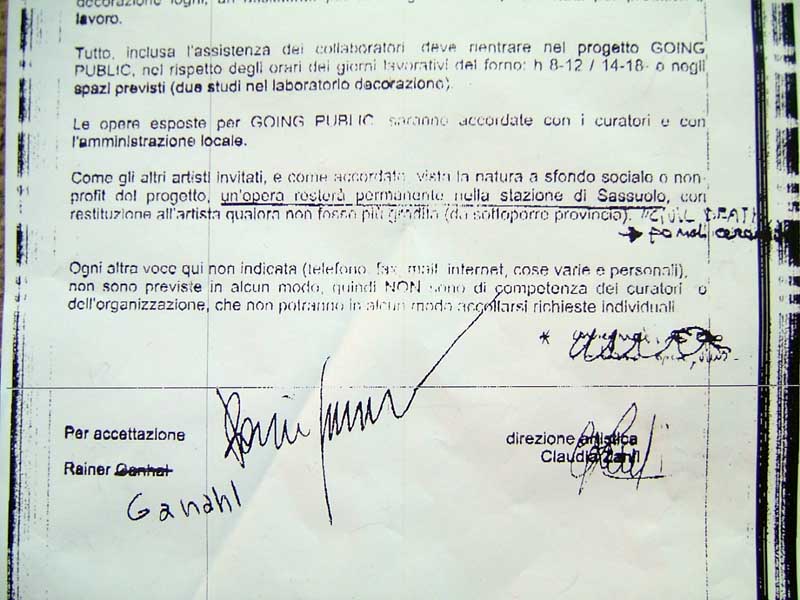
here is the email, that this curator Zanfi sent to Italy declaring the work to be owned by Sassuolo. which is a pure lie. but based on this lie, the museum had no choice but to return the invoice.
-----Ursprüngliche Nachricht-----
Von: Claudia Zanfi [mailto:czanfi@libero.it]
Gesendet: Freitag, 20. Februar 2004 12:03
An: Steyrer, Dagmar
Betreff: missing of our art work
Wichtigkeit: Hoch
already sent by FAX:Dear Mrs Dagmar,
I’m really sorry to announce you that a very unfortunate fact happend
during your transportation of Ganahl’s works in Modena.
As we agreed, you should take one big panel in Stazione Provinciale di
Modena and various boxes in Forme 2000 Sassuolo. But only yesterday I’ve
been advised that your tansport guys went also to the Stazione of Sassuolo
to take another NOT MENTIONED PANEL, that belongs to the City.
We have a very clear contract signed by Rainer Ganahl: we produced all
his works, and
– as to all the other artistis – we asked to give a piece to
the City for public places.
GANAHL SIGNED a contract of agreement about all that.
We have already called our lawyers and they confirmend that the Ganhal’s
contract with us and the Municipality is correct and has an international
value, before any other succesive disposition.
I realy don’t understand how and why your transports went also to
pick up a not mentioned panel, without my agreement!!!
On Tuesday 24 February we’re planning an important PRESS CONFERENCE
to the Sassuolo Station with authorities of the city, to show all the
works of the public art project “Going Public”,
and to present a new publication on “Mobility and nomadism”.
Therefore I’m also very sorry to announce that if Ganahl panels won’t
be there for that date we have to denounce at the police an act of theft
against the City of Sassuolo and the hole Municipality of Modena.
It would be very unpleasant if your Museum should be - in a way - involved
in that act, of removing a NOT AUTHORISED art work.
Waiting for any proposal,
best regards
claudia zanfi
artistic director MAST
aMAZE cultural lab
via cola montano 8
20159 milano - italy
mobile 338-7642577
tel/fax 0039-02-6071623
mail: info@amaze.it
www.amaze.it
------------------------------------
here is the emai that speaks of the same complications and that the work is mine. sent after Zanfi sent her letter:
it also states that if there was a misunderstanding the work would be given back:
"Obviously, if there was a misunderstanding between you and Mrs.
Zanfi, the
Province of Modena will never claim for property of an artwork that
doesn't"
-------------------------------------------------------
From: "Benedetti Luigi" <benedetti.l@provincia.modena.it>
To: "rainer" <r>
Cc: "Claudia Zanfi" <czanfi@libero.it>
Date: Sat, 6 Mar 2004 09:27:20 +0100
Dear Mister Ganhal,
I think you should make all this clear with Claudia Zanfi.
In fact, last september I received by Amaze a deed of gift for your
artwork,
and not a loan, signed by Claudia Zanfi / Amaze.
On that basis, the Province of Modena accepted the gift with an her
own act,
binding to preserve and to exhibit your work.
If you want, I can send you a copy of this act.
I was informed that you agreed with Mrs. Zanfi about that solution.
I believe there must be some kind of misunderstanding between you
and Mrs.
Zanfi, and I suggest you to contact her to find a proper solution to
the
problem, verifying the content of the documents you signed.
Obviously, if there was a misunderstanding between you and Mrs.
Zanfi, the
Province of Modena will never claim for property of an artwork that
doesn't
belong to her.
With best regards,
Luigi Benedetti
-------------------------------------------------------
after this. I was offering again a loan
NEARLY TWO YEARS LATER - THE WORK WAS RETURNED (I HAVEN'T HAD YET THE TIME IT CLEAN UP THIS PAGE)
THANKS TO EVERYOBYD INVOLVED.. S